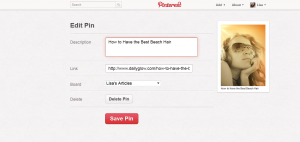 As a freelance writer and social media marketer, I’m always looking for new social media sites to delve into as well as new ways to promote my digital content. Like many Internet users of the world, I quickly became hooked on Pinterest, but only recently began promoting my content using through the Pinterest network.
As a freelance writer and social media marketer, I’m always looking for new social media sites to delve into as well as new ways to promote my digital content. Like many Internet users of the world, I quickly became hooked on Pinterest, but only recently began promoting my content using through the Pinterest network.
Whether you are a writer, article marketing specialist, small business owner or just someone looking to build your brand, you can promote your own articles, blog posts and Web content successfully using Pinterest. The site has 1,090 visitors per minute and when done correctly, you can tap into this enormous market for yourself.
Here are some tips on how to do it right.
Publish High Quality and Interesting Content
Your first step is to publish something people want to read. There is no shortage of content on the Internet today so you need to be sure what you’re publishing has a real value to readers and is not just rehashed content of what is already available. Consider who follows you on Pinterest. Having a following that is appropriate to your niche will only help since your followers will be the first users to be exposed to your pin.

Always use high resolution images that are pertinent to your linked content. Relevance will build trust in your audience and keep them coming back for more.
The most important things to include in your submission:
- An interesting and searchable title/headline
- A high resolution quality image
Once you’ve written and posted this article with at least one high quality image, it’s time to share it on Pinterest.
Post it to Pinterest
Once your article is published it’s time to post it to Pinterest. If you have a Pinterest plugin on the site, you can use this to easily add your content to pin boards. If not, you can submit it manually by going to your Pinterest account, selecting or creating the board it fits in and adding the article and photo. Alternatively, you can use the Pin It feature on your browser.
When posting the article to Pinterest, here are some things to be aware of:
- Make sure the image you select is crisp, clear and attractive. Pinterest revolves around images so you want something that is eye-catching and will cause users to stop to look more closely at your image.
- Include the interesting, searchable headline that applies to your article.
- Include the link to the article. If you miss this very important step, you will only pin the photo and the title but with no link that takes traffic back to your actual content.

Always review your submission to make sure you have completed all the desired fields. This is also a good time to consider the relevance of the various fields and image independently.
Keywords and Topic Selection
To get the most from your posts on Pinterest, be sure to choose the appropriate category and include some keywords. Pinterest users often use the search feature to find relevant pins and content. Proper tagging will increase your chances of appearing in search and will improve your the likelihood of connecting with people who are interested in your content. Since the average user spends 15.8 minutes on the site per visit, there is quite a bit of leisure time spent on the site, which indicates heavy use of filtering features like search.
Pinterest is also integrated with Google search and Facebook. If you use the word Pinterest in your search term on Google it will often give you a Pinterest category in the results. A recent search inquiry I made on ‘Pinterest Use Statistics’ in preparation for writing this article brought up the category page for Pinterest Statistics.
After playing around for a few minutes I realized that attaching the word Pinterest to just about any other word would bring up either a particular Pinterest category or append that term to the Pinterest search URL. There are currently 213 followers, and only 14 pins in the Pinterest statistics category; odds are good that your content will convert impressions into traffic. According to the Ad Words keyword tool, users in the United States include the word Pinterest in Google search inquiries 3,350,000 every month.
I have tracked these methods and experienced a noticeable increase in traffic to my digital content. As a bonus, I also Tweet the Pin to my Twitter followers shortly after I post it. You can also resurrect older articles that have been pinned by going back to your boards and re-tweeting or sharing them to Facebook again several weeks after the initial share. Repeat this process over time and you will see continued traffic to your articles that have been pinned.
- WordPress vs. Blogger: Which is Best? - February 4, 2025
- Instagram for Business - January 4, 2024
- Privacy Settings in Social Media - June 20, 2021
- Seven Premium Social Media Tracking and Analytics Tools - January 26, 2021
- Social Media College Degrees and Courses - July 3, 2019
- Get the Most Out of Your Content By Optimizing for Success - May 29, 2019
- Impact of Social Media on Society: 5 Times Social Changed the World - February 17, 2019
- The Power of Social Media for Bloggers - September 17, 2013

I have a question for you, Adam. I’m reading more and more attorneys telling us not to use Pinterest because of the Terms of Use. Apparently, if we post our work then Pinterest can use it in any way they want without remuneration or even letting us know. But, more frightening, is that they can use anything we post from others in the same way…and have us be held accountable should they be sued for using the content. How do you feel about this? I’ve not done anything about joining Pinterest because of this.
Well, Pinterest doesn’t have the right to make a transfer of rights binding when YOU don’t have the rights in the first place. This becomes a gray area when you take a picture of something that conveys intellectual property, or as I read in a blog post not too long ago if you took a picture of a painting. The painter has rights to the painting, but you actually have rights to the picture, so you could by definition grant your rights to the picture to Pinterest. If you pin something from my site however, all I have to do is file a DMCA notice with Pinterest and they will remove the image – that is, if I had the rights to do so in the first place.
You are only allowed to post a picture to the Internet by law if you have the rights to it. The only exceptions is creative common licensing and fair use (which aren’t going to be the pictures that do well on Pinterest). So if you didn’t take the picture and it didn’t come from a press release, wikimedia or a creative commons website, you don’t have the rights to transfer to Pinterest.Pinterest likely has that ToS agreement in place to protect themselves. I don’t see them re-printing submitted pictures in books or anything. I always thought it was weird that I had to get the copyright of a picture of me transferred from the photographer before I can use it, but that’s how it is. The photographer has the rights when it’s created, and Pinterest has you sign those rights over to cover their own ass. Since about 95% of the pictures on Pinterest aren’t shared by the person who actually has the copyright (and therefor cannot transfer it) it’s just a Way for Pinterest to say “Look, you can’t sue us, this user said that they had the rights to transfer to us”. Most organizations will not pursue litigation against private individuals, but eventually there will be an individual case that will cross a line. There’s always going to be a buffer between Pinterest and the Plaintiff, at least as the laws are on the books now.If you want to be totally in line with the laws, join Pinterest and only share pictures you take with a camera. They probably aren’t going to re-sell them (but then again, they used affiliate linking so who’s to say they won’t start a site like shutterstock?). The Internet is full of this kind of copyright violation though, so you’d really be getting singled out if anything more than a DMCA notice came out of re-sharing a copyrighted picture. 4chan, Canvas, all the image sharing sites routinely break this law (flickr too) but we’re only hearing about it now because Pinterest is getting really big. You’re probably seeing more articles than are appropriate on the matter too because people know that this is a topic of debate right now.
Good question Dr Rhia 🙂
Great read Lisa, thank you. And thank you Adam for sharing this blog. I do like Pinterest, but I think it needs a clear strategy first. I deleted my boards and am starting again, so these tips will be very useful. Thank you Lisa.
Thanks Gaye. I appreciate you reading and I am following you on Pinterest already. I look forward to seeing your new boards and creation.
Thanks for the tips Lisa, great points. You are right out in front on this.
Thank you Michelle. I appreciate you reading.
This is helpful and well-explained, but what should those of us who are not photographers do? Is it worthwhile paying for stock photos, or should we concentrate our efforts elsewhere?
Well, what is it you are trying to promote? For example, I use Pinterest to promote my articles and blog posts so I use the photo that I include on the site where the piece is published. Photography skills not necessarily needed.
Nancy, it is probably not worthwhile paying for stock photos unless you run a website that gets tons of traffic. Have you ever tried to take your own pictures? You may be better than you think!
Remember that there are tons of pictures on the Internet that have creative commons licensing, so you are allowed to share them without violating copyright. Like Lisa said, it depends more on exactly what you’re trying to do than anything. If all you’re wanting to do is get popular on Pinterest, I would recommend trying to make your own photos. If you have a business in a specific niche, let us know and odds are we know of a place where you can find things to share on Pinterest.
I do want to clarify though: The best dividends for businesses are realized by businesses that have products to sale. Products that are particularly visual, and directed at women. Photography studios, chefs, people that crochet and make crafts, artists, etc. They take pictures of their products. I don’t think a lot of people realize that marketing other things on Pinterest isn’t ever going to put you in the top 20 users list, and the traffic isn’t going to be worth as much as it would for Cover Girl magazine or something. It’ hilarious to me that in England the top Pinterest demographic is Men who are trying to break into social media marketing 🙂
I don’t have any clients that would benefit from Pinterest any more than they would from Facebook (I was a mouse hair away from taking on a cupcake business last month, and that is a regular business that I would send straight to Pinterest). It’s a good idea to try it out with what you have to offer, and measure to see if it’s more beneficial than what you’re doing, or if you can get the time investment down, is it worth keeping up? Until then, it’s just a guess if I was to try and answer that question.